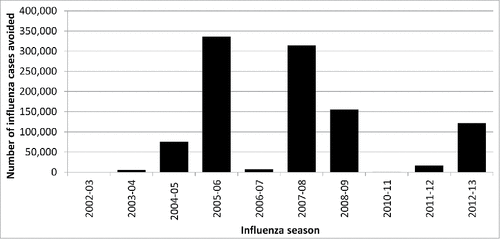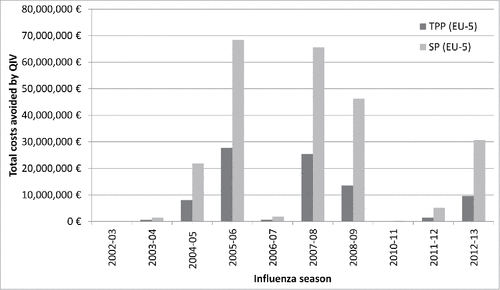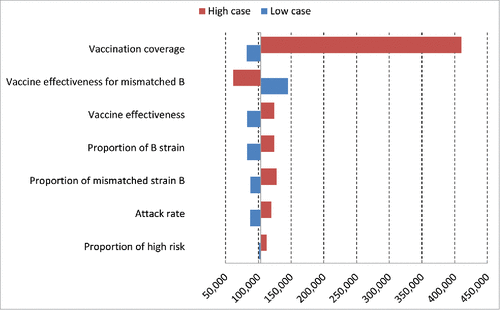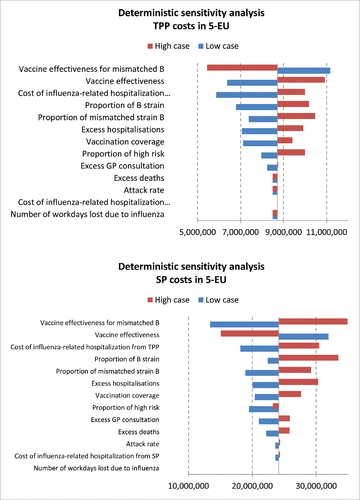Figures & data
Table 5. Proportions (%) of influenza A and B (B Victoria and B Yamagata) strains circulating in the 5-EU countries by influenza season between 2002 and 2013. For France, Germany, Italy and Spain, data from came from ref. Citation42 for the 2002–03 season, from ref. Citation43 for the 2012–13 season and from ref. Citation1 for all other seasons. For UK, data came from ref. Citation26 for the 2003–03 to 2008–09 seasons, from ref. Citation1 for the 2010–11 and 2011–12 seasons and from ref. Citation43 for the 2012–13 season.
Table 6. Influenza vaccination coverage (%) by country, age and risk group for EU-5.
Table 7. Vaccination efficacy/effectiveness against influenza A, matched influenza B and mismatched influenza B used in the model. The lower and upper bound correspond to a variation of +/−20% in vaccine effectiveness. Cross protection was included in the model by considering that VE against mismatched B was 67% of the VE against matched B.
Table 1. Absolute number and incidence per 100,000 inhabitants of influenza cases, GP consultations, workdays lost, hospitalizations and deaths due to influenza avoided for the 5 EU countries for the 2002–03 to 2012–13 influenza seasons. Epidemiological burden avoided are presented with the lower and upper bound corresponding to a variation of +/−20% in vaccine effectiveness.
Table 2. Epidemiological burden averted (absolute numbers and incidence per 100,000 inhabitants) by age-group for the 5 EU countries for the 2002–03 to 2012–13 influenza seasons. Epidemiological burden avoided are presented with the lower and upper bound corresponding to a variation of +/−20% in vaccine effectiveness.
Figure 1. Influenza cases avoided per season for the 5 EU countries if QIV vaccine was used instead of a TIV vaccine during the 2002–03 to 2012–13 influenza seasons.

Table 3. Total costs for GP, hospitalizations and workdays lost avoided for the 5 EU countries for the 2002–03 to 2012–13 influenza seasons.
Table 4. Total costs avoided for the 5 EU countries according to age and risk groups, and perspectives in million Euros for the 2002–03 to 2012–13 influenza seasons.
Figure 2. Total costs avoided if QIV vaccine was used instead of a TIV vaccine according to TPP and SP perspectives for the 5 EU countries for the 2002–03 to 2012–13 influenza seasons.

Figure 3. Deterministic sensitivity analysis represented by tornado charts reports the impact of the parameters on the number of influenza cases per season in EU-5.

Figure 4. Deterministic sensitivity analysis represented by tornado charts reports the effect of varying various parameters on the average cost savings per season according to TPP and SP for the 5 EU countries during the 2002–03 to 2012–13 influenza seasons.

